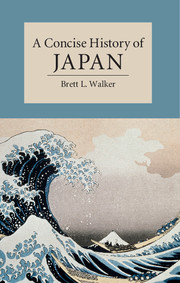Book contents
- Frontmatter
- Dedication
- Contents
- List of Illustrations
- List of Maps
- Preface
- Chronology
- Introduction
- 1 The Birth of the Yamato State, 14,500 bce – 710 ce
- 2 The Courtly Age, 710–1185
- 3 The Rise of Samurai Rule, 1185–1336
- 4 Medieval Japan and the Warring States Period, 1336–1573
- 5 Japan’s Encounter with Europe, 1543–1640
- 6 Unifying the Realm, 1560–1603
- 7 Early Modern Japan, 1600–1800
- 8 The Rise of Imperial Nationalism, 1770–1854
- 9 Meiji Enlightenment, 1868–1912
- 10 Meiji’s Discontents, 1868–1920
- 11 The Birth of Japan’s Imperial State, 1800–1910
- 12 Empire and Imperial Democracy, 1905–1931
- 13 The Pacific War, 1931–1945
- 14 Japan’s Post-War History, 1945–Present
- 15 Natural Disasters and the Edge of History
- Glossary
- Further Reading
- Index
1 - The Birth of the Yamato State, 14,500 bce – 710 ce
Published online by Cambridge University Press: 05 March 2015
- Frontmatter
- Dedication
- Contents
- List of Illustrations
- List of Maps
- Preface
- Chronology
- Introduction
- 1 The Birth of the Yamato State, 14,500 bce – 710 ce
- 2 The Courtly Age, 710–1185
- 3 The Rise of Samurai Rule, 1185–1336
- 4 Medieval Japan and the Warring States Period, 1336–1573
- 5 Japan’s Encounter with Europe, 1543–1640
- 6 Unifying the Realm, 1560–1603
- 7 Early Modern Japan, 1600–1800
- 8 The Rise of Imperial Nationalism, 1770–1854
- 9 Meiji Enlightenment, 1868–1912
- 10 Meiji’s Discontents, 1868–1920
- 11 The Birth of Japan’s Imperial State, 1800–1910
- 12 Empire and Imperial Democracy, 1905–1931
- 13 The Pacific War, 1931–1945
- 14 Japan’s Post-War History, 1945–Present
- 15 Natural Disasters and the Edge of History
- Glossary
- Further Reading
- Index
Summary
Japan’s environment proved much more than simply a sculptor of Japanese civilization, where wind and rain painstakingly chiselled, over the centuries, the intricate contours of Japanese life. Rather, the environment was a product of Japanese civilization. Early inhabitants of the Japanese Islands, from the Yayoi archaeological phase (300 bce – 300 ce) onward, carved, sliced, burned, and hoed their subsistence needs and cultural sensibilities into the alluvial plains, forests, mountainous spine, and bays of the archipelago, transforming it, like some colossal bonsai tree, into a material manifestation of their needs and desires. This is the most profound disjuncture between the Jômon archaeological phase (14,500 bce – 300 bce) and the Yayoi: the introduction of East Asian culture and its transformative effect on the archipelago. This chapter explores the emergence of the earliest Japanese state, and how state development was intimately connected to environmental transformation.
Early Foragers and Settlers
The Pleistocene Epoch, about 2.6 million to 11,700 years before present (ybp), witnessed the first wave of early hominid, non-human animal, and incidental plant migrations across Eurasia and onto the Japanese archipelago. Japan was not an archipelago at the time, however. Rather, it was connected to the continent at both the southern and northern sections by coastal lowlands that formed a terrestrial crescent with the Sea of Japan serving as what must have been an impressive inland sea. Whether modern hominids came from Africa and displaced earlier hominids, or the earlier arrivals evolved into modern hominids, is still debated, but by 100,000 ybp many palaeolithic foragers roamed Eurasia, and some of them wandered onto this terrestrial crescent in pursuit of game and other foraging opportunities. The 1931 discovery of a left pelvic bone first suggested palaeolithic habitation of the terrestrial crescent, but air raids destroyed the bone during the Pacific War (1937–45) and the bone’s discoverer was only vindicated with the later unearthing of other palaeolithic remains throughout Japan.
- Type
- Chapter
- Information
- A Concise History of Japan , pp. 10 - 25Publisher: Cambridge University PressPrint publication year: 2015



